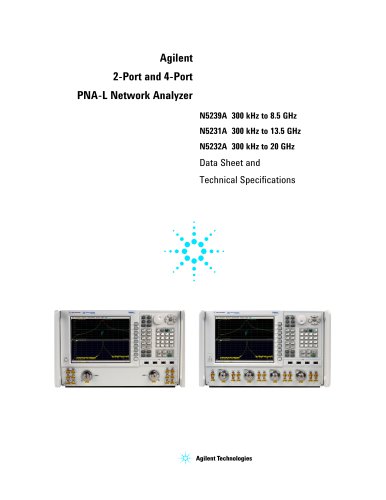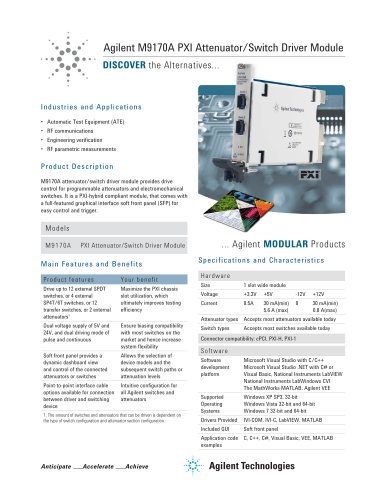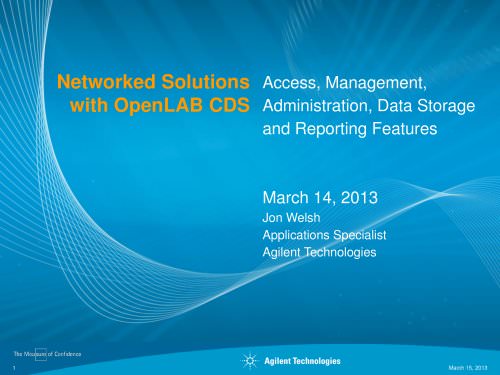
Catalog excerpts

Bio-inert UHPLC The 1260 Infinity Bio-inert LC System Sebastian Krahe Produktspezialist Agilent Technologies 1
Open the catalog to page 1
Good Reasons for Having a Dedicated Bio-inert HPLC Protein Analysis: • Unspecific surface binding • Low throughput, low resolution • Peak tailing for critical proteins • Corrosion and pH issues with standard LC • Decreased column lifetime and chromatographic performance Other Applications: • • high pH applications • 2 metal-free chromatography Phosphorylated compounds, oligonucleotides
Open the catalog to page 2
1260 Infinity Bio-inert HPLC What is similar to standard 1260 Infinity? Based on proven technology System performance specification System Robustness 600 bar (UHPLC) for fast or high resolution bio-separations without any compromises! 3
Open the catalog to page 3
1260 Infinity Bio-inert HPLC What´s new ? No corrosion due to high salt Sample management completely metal-free No usage of MP35N capillaries with cobalt, nickel, chromium… pH-range 1-13, shortterm pH 14 low and high pressure possible large volume injections • Widest pH range • High salt tolerance • Lowest surface activity no passivation needed !! 4
Open the catalog to page 4
New Capillary Design Ensures Bio-inertness Capillaries Metal cladded PEEK capillary Newest fitting design: Hybrid technique New capillary technolgy enables 600 bar AND is completely metal free !! 5
Open the catalog to page 5
Proof of concept: surface activity 300 200 100 90 % MeOH 400 70 % MeOH 500 Solvents Buffer A: 10 mM ammonium acetate Buffer B: 10 mM ammonium acetate +10% methanol Buffer C: 10 mM ammonium acetate +50% methanol Buffer D: 10 mM ammonium acetate +70% methanol Buffer E: 10 mM ammonium acetate +90% methanol 50 % MeOH 600 Chromatographic conditions Flow rate: 0.5 mL/min Isocratic run with buffer A, B, C, D or E Stop time: 5 minutes Injection volume: 0.2 μL Temperature TCC: 40 °C Diode array detector: 254 nm No column, PEEK restriction 10 % MeOH mAU 0 % MeOH ATP Analysis – 1260 Infinity standard...
Open the catalog to page 6
Proof of concept: low surface activity 90 % MeOH 70 % MeOH 700 50 % MeOH mAU 10 % MeOH 0 % MeOH ATP Analysis – 1260 Infinity Bio-inert LC Chromatographic conditions Flow rate: 0.5 mL/min Isocratic run with buffer A, B, C, D or E Stop time: 5 minutes Injection volume: 0.2 μL Temperature TCC: 40 °C Diode array detector: 254 nm No column, PEEK restriction 600 500 400 Solvents Buffer A: 10 mM ammonium acetate Buffer B: 10 mM ammonium acetate +10% methanol Buffer C: 10 mM ammonium acetate +50% methanol Buffer D: 10 mM ammonium acetate +70% methanol Buffer E: 10 mM ammonium acetate +90% methanol...
Open the catalog to page 7
Quaternary Buffer Mixing with Buffer Advisor and 1260 Infinity Bio-inert LC System 8
Open the catalog to page 8
1. Select Buffer S Gradient Mode (• Cation Exchange C Pnion Exchange 3. Compose Stock Solutions Ionic Strength Dilute online or add salt for salt Agilent Technologies
Open the catalog to page 9
…Saving Time and Resources…. Instead of setting up different bottles with different pH… 10 …you use a quaternary Bioinert LC with Buffer Advisor software to instantly run salt- and pH gradients
Open the catalog to page 10
Simplifies Ion Exchange Workflows Buffer Advisor SW Customer benefits: Ease of use • Automates preparation of separation buffers for IEX from stock solutions • Eliminates the need to prepare multiple buffer solutions • Provides recipes for buffer preparation Increase of productivity • Simplifies pH scouting studies • Simplifies pH gradient setup Increase of Robustness and run to run repeatibility • Compensates for pH shifts in salt gradients • Calculates optimized gradient steps 11
Open the catalog to page 11
Process Help 1. Select Buffer & Gradient Mode Single Buffer *- Composite Buffer {pH / Salt Gradient} [Wide Range pH Gradient} f* Cation Exchange C Anion Exchange 2. Define Gradient Table j. Compose Stock Solutions Ionic Strength Export Gradient Time Table... Minimum Buffering Capacity (BC) =3.15 j Agilent Technologies
Open the catalog to page 12
Single Buffer [pH / Salt Gradient) Cation Exchange Sodium Citrate [Citric + Tri-Sodium Citrate) Sodium Citrate [Citric + NaOH) ; /Formic/Na [acid + Na salt) | Formic/Na [acid + NaOH) ; /Lactic/Na [acid + Na salt) I Lactic/Na [acid + NaOH) ; /AcetidNa (Acetic+Acetate/Na) ^J/SuccinidNa [acid + Na salt) Succinic'Na [acid + NaOH) .^MalonidNa [acid + Na salt) | . MalonidNa [acid + NaOH) ^MES/Na (MES+MES/Na) MESiNa [MES+NaOH) 1. Select Buffer & Gradient Mode [Wide Range pH Gradient) (* Cation Exchange Agilent Technologies
Open the catalog to page 13
2. Define Gradient Table 3. Compose Stock Solutions Stock Solution Recipes Bottle C |NaH2P04: Monosodium phosphate Bottle D |Na2HP04: Sodium phosphate dibasic Print Preview. Agilent Technologies
Open the catalog to page 14
Step 3: Press Process and obtain your new optimized gradient table and the corresponding display Export the Gradient Timetable as xml file 15
Open the catalog to page 15
Step 4: Import the Gradient timetable into OpenLAB CDS ChemStation 1. Go to the OpenLAB CDS ChemStation and set up and save a new method, 2 . Go to the Quat Pump tab and click Import Solvent Blending File 3.Select the file that you have generated in the Buffer Advisor software 16
Open the catalog to page 16
Determination of Low Metal Release in the 1260 Infinity Bio-inert LC The Agilent 1260 Infinity Bio-inert Quaternary LC system releases less metals using acidic, basic, and salt containing buffers compared to • • 17 the Agilent 1260 Infinity LC stainless steel system and to the bio-inert LC system from another vendor
Open the catalog to page 17
Agilent Technologies
Open the catalog to page 18
Applications Agilent has a complete solution for bioanalytical workflows including LC-Instrument, column and applications Typical applications for the 1260 bio-inert LC in Biopharma: 1. Aggregate analysis of mABs with SEC 2. Charge variant analysis with WCX 3. Peptide Mapping with RP 4. Glycan analysis with HILIC, RP or AEX 5. Structural analysis with HIC 19
Open the catalog to page 19
Characterization of therapeutic proteins and monoclonal Antibodies drugs 1. Physical and chemical characterization (product characterization) 2. Potency/activity 3. Product related impurities 4. Process related impurities Heavy Chain Antigen binding Light Chain Pyroglutamate Disulfide shuffling Fab Deamidation/oxidation Hinge Fc 20 Truncation (lysine) Glycosylation site
Open the catalog to page 20All Agilent Technologies - Life Sciences and Chemical catalogs and technical brochures
-
Agilent 280 Series AA Systems
12 Pages
-
Inorganic Standards
40 Pages
-
InfinityLab LC Supplies
148 Pages
-
General Chromatography
164 Pages
-
Sample Preparation (2018/2019)
144 Pages
-
MS500
12 Pages
-
FLAME ATOMIC ABSORPTION SPECTROSCOPY
104 Pages
-
Agilent training
27 Pages
-
AGILENT VACUUM PRODUCTS CATALOG
536 Pages
-
Vacuum Measurement Catalog
44 Pages
-
AGILENT ION Pumps
53 Pages
-
AGILENT DIFFUSION PUMPS
35 Pages
-
AGILENT Rotary Vane Pumps
29 Pages
-
Agilent InfinityLab LC Series
16 Pages
-
3100 fractionator
8 Pages
-
4200 MP-AES
12 Pages
-
Agilent GPC/SEC Solutions
12 Pages
-
Agilent?s biomass solutions
12 Pages
-
X-ray Crystallography
12 Pages
-
Agilent ProPulse NMR System
5 Pages
-
An autosampler like no other
4 Pages
-
Agilent U1450A/U1460A
19 Pages
-
Agilent B1507A
22 Pages
-
Agilent M9703A
16 Pages
-
W1905 Radar Model Library
16 Pages
-
M8048A ISI Channels
7 Pages
-
Agilent J-BERT M8020A
27 Pages
-
Agilent N8900 Series
10 Pages
-
I/O Hardware
16 Pages
-
Advanced Design System
16 Pages
-
RF & Microwave Attenuators
4 Pages
-
E4980AL Precision LCR Meter
8 Pages
-
FieldFox Handheld Analyzers
8 Pages
-
AFM/SPM Accessories
20 Pages
-
VEE 9.32
24 Pages
-
89600 VSA Software
9 Pages
-
Command Expert
2 Pages
-
E5061B Network Analyzer
8 Pages
-
E5071C ENA Network Analyzers
18 Pages
-
N9038A MXE EMI Receiver
2 Pages
-
N9322C Basic Spectrum Analyzer
10 Pages
-
Digital Multimeters
25 Pages
-
M9361A PXI Downconverter
2 Pages
-
Power Meters and Power Sensors
34 Pages
-
E7515A UXM Wireless Test Set
2 Pages
-
Agilent Power Products
31 Pages
-
E5063A Network Analyzer
8 Pages
-
Leak Detection Catalog
41 Pages
-
Agilent 7820A GC brochure
8 Pages
-
Agilent GC-MSD and QTOF
96 Pages
-
Agilent GC-MSD 5977
39 Pages
-
Agilent Intro BERLIN
24 Pages
-
1290 Infinity Quaternary LC
24 Pages
Archived catalogs
-
Diffusion Pumps Catalog
37 Pages






















































































































































